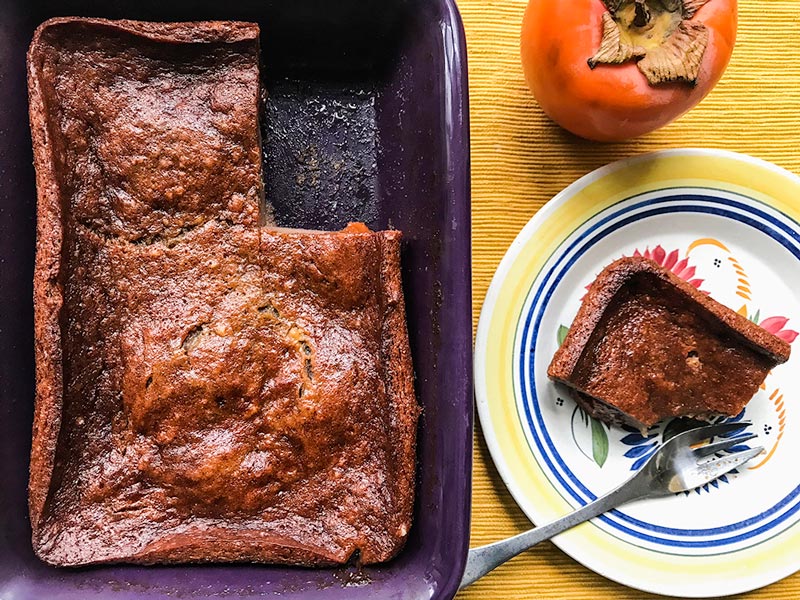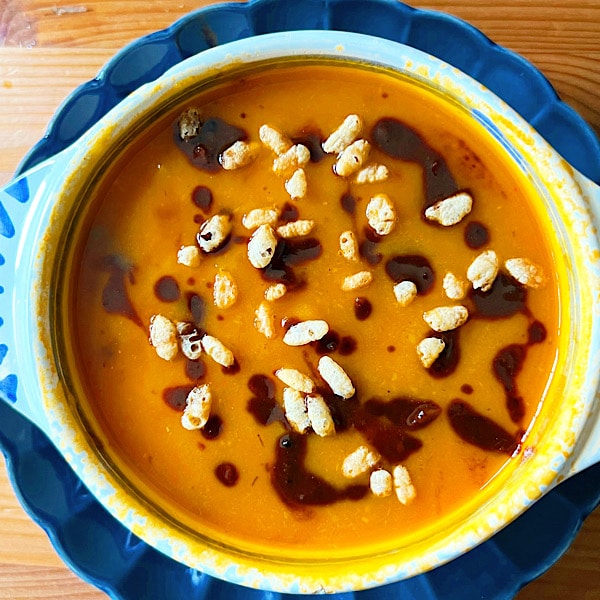The recipes for persimmon pudding I’ve come across are all very enticing to food historians. They go on and on about its old-fashionedness, its popularity in Indiana (There’s a contest every year!), how Captain John Smith was tormented by wild persimmons’ astringency when he first tasted them in the New World, etc. One thing no recipe seems to tell you about persimmon pudding, though: how utterly, hauntingly delicious it is or how the strange and slippery translucent persimmon flesh turns the most basic ingredients into a luscious, caramel-y dessert that defies description and explanation.
On paper, your classic, old-fashioned persimmon pudding recipe looks a lot like a banana bread batter, only with persimmons. In the bowl—ditto—a fairly liquid batter. But once baked, persimmon pudding doesn’t rise into a loaf, despite the baking powder and baking soda that’s used. Instead, it becomes dense and flan-like with a chewy crust…a texture I can only credit to the persimmon purée, which is thick, somewhat gooey, mildly-flavored and very sweet. The closest comparison to persimmon pudding I can find is sticky toffee pudding, a lusciously moist British dessert with hints of fruit and caramel. The tastes, textures and preparation steps are similar—only you can feel a lot less guilty about eating persimmon pudding because so much of the sweetness comes from a fruit (persimmon) purée.
Which brings me to another thing those traditional, prize-winning, passed-down-through generations recipes for persimmon pudding don’t tell you: You don’t need all that sugar that goes into them! I slashed the amounts I found in various recipes and the dessert still tasted decadently sweet and decidedly old-fashioned, in a good way.
Now, I want to tell everyone about persimmon pudding. I want everyone to make it. (It’s as easy as banana bread!)I want it to dethrone pumpkin pie as the top holiday dessert in America (apparently it comes close to doing so in Indiana). But mostly, I want persimmon season in France to last longer than it does, so I can keep making puddings well into winter when the rich, homey flavors of an ultra-easy recipe are especially welcome.
(PS When I first tasted this recipe, the texture reminded me of a far Breton, a dense, clafoutis-like flan that’s made with prunes. That’s why I added prunes to the recipe.)
2 soft, very ripe large Hachiya persimmons
1 egg
2/3 cup (140 g.) granulated or cane sugar
½ tsp. baking powder
½ tsp. baking soda
1/8 tsp. salt
pinch cinnamon or ½ tsp. vanilla extract, optional
¾ cup (175 ml.) whole milk or buttermilk
¾ cup (100 g.) flour
2 Tbs. (30 g.) melted butter
12 prunes, optional
PREHEAT the oven to 350˚F. Butter an 8- x 8-inch baking dish (or equivalent size).
Halve the persimmons and scoop the flesh into a bowl. Mash until smooth. Alternately, whizz the persimmon flesh in a blender or food processor until smooth. You should have 1 cup.
WHISK the egg with the sugar in a medium bowl. Whisk in the baking powder, baking soda, salt, and flavoring (if using), then whisk in the persimmon purée and buttermilk. Fold in the flour and then the melted butter using a whisk or a spatula.
POUR the batter into the prepared baking dish. Arrange the prunes over the batter, if using. (They will sink.) Bake 30 to 35 minutes, or until the pudding is brown on top and beginning to pull away from the sides of the baking dish and a toothpick inserted in the center comes out clean. Cool completely before slicing and serving with whipped cream or fresh fruit.



Funny I happen to be from Indiana yet have never tasted this
Kim, here’s an article on it from the Indy Star…https://eu.indystar.com/story/life/2017/11/19/famous-persimmon-pudding-recipe-150-years-old/872775001/. You should try it! I’m on my third batch this year and am even thinking of freezing some persimmon purée for later this winter when I can no longer find the fresh fruit.
Just a quick note about persimmons used in this recipe. Those “traditional, prize-winning, passed-down-through generations recipes for persimmon pudding” (many from Mitchell, Indiana, home of the annual Persimmon Festival) use the pulp made from the native American persimmon (Diospyros virginiana). Much smaller and tannic than their Asian cousins with a deeper, liquory flavor, American persimmons require significantly more sweetener to balance the tannins.
Hi Kim, Thank you for such an informative (and beautifully written) explanation of American persimmons. I used to collect them in Virginia in the late fall but was never able to gather enough for pudding.
How do you make a smaller portion?
Tricky question! This doesn’t make a lot, but if you wanted to halve the recipe, you could use just a yolk instead of the whole egg.